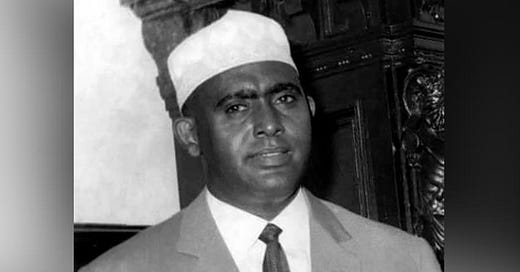'Las Anod's bloody reputation was reinforced': Time magazine on the assassination Abdirashid Ali Shermarke (1969)
Abdirashid Ali Shermarke was Somalia's last elected president by universal suffrage. Assassinated 54 years ago today, his murder was watershed moment in Somalia's political history.
We’re bouncing around a lot in terms of time, but this post takes us right back to the beginning of the period I’m using this blog to explore. It is quite easy to find archival material in newspapers and magazines these days, but not so easy to find a piece which gives really great insight into an issue.
A brief summary for all of you. Abdirashid Ali Shermarke was the last Somali president elected by universal suffrage. Siad Barre didn’t face polls during his two decades in power and every president since the transitional government was reconstituted in 2004 by Abdullahi Yusuf has only come to power through horse-trading and bribes among the new political class. His assassination in that sense was a watershed moment, not only laying the groundwork for a military dictatorship which would rule the country until 1991, but he was also the president whose elected represented an expression of the political will of the Somali public.
This piece below is concise, appreciates the clan background of the individual who assassinated Abdirashid Ali Shermarke, whilst avoiding falling into the conspiracy about possible Great Power involvement in Shermarke’s demise – which I’m not ruling out but we should avoiding making claims without evidence. One of the strangest things is that the details of the murder remain largely a mystery to this day. The piece appeared in Time magazine on the 24th October 1969. That is a full nine days after the act. And 54 years ago today.
Link here. Enjoy the read.
Since the Somali Republic became independent in 1960, it has never experienced a coup—military or otherwise. There have been political killings aplenty, however. In last March's national elections, at least five officials of the ruling Somali Youth League were assassinated, and 16 persons died in a scuffle at Las Anod, a remote settlement in the nomadic grazing lands of the north. Last week Las Anod's bloody reputation was reinforced. As President Abdirashid Ali Shermarke, 49, stepped from his car in Las Anod on the last stop of a ten-day tour of the drought-stricken north, he was shot dead by a 22-year-old policeman, who then quietly surrendered.
Little Unrest. It seemed a pointless killing. Shermarke had gained a mild reputation abroad as a troublemaker when he served as the nation's first Prime Minister between 1960 and 1964, largely because of his efforts to obtain sovereignty over those parts of northern Kenya and eastern Ethiopia roamed by Somali nomads. His domestic policies, however, had produced little unrest. After a three-year period out of office, he was elected President in 1967. He chose as his Prime Minister Mohammed Haji Ibrahim Egal, 41, who promptly proceeded to end the border frictions.
Despite this seeming reversal of Shermarke's "Greater Somalia" policies, there was no evidence of friction between President and Prime Minister. Nor, for that matter, were there important political tensions in the nation itself. Then why was Shermarke killed? The assassination might have resulted from a personal or tribal grudge: the alleged killer, Abulkadir Abdi Mohammed, belongs to the same tribal family as Shermarke, though not to the same clan.
Within a month, the National Assembly is scheduled to meet to elect a new President. No matter who wins, Somalia is expected to continue its recent policy of live-and-let-live with neighboring Kenya and Ethiopia.


